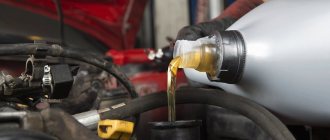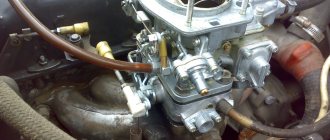Do I need to change the oil in the box?
Drivers, especially newbies, quite often forget that the gearbox oil requires regular replacement. They tend to think that one fill can cover more than several hundred kilometers.
And thus they cause irreparable harm to the vehicle, even to the point of replacing some technical components.
Automatic in the box
Oils intended for automatic transmissions must be changed strictly at intervals of 25,000-50,000 kilometers. If the car is operated carefully and not every day, then it is possible to reach 70,000 kilometers. But it must be borne in mind that the longer the owner delays changing the oil in the gearbox, the more it clogs.
This is explained by the loss of the lubricating fluid of its basic properties as wear products accumulate. As a result, the bushings and bearings begin to rub against each other - scuffing appears, accelerating the wear of all components.
It is even more dangerous if oil leaks are observed. This problem occurs especially often in winter. The transmission box is subjected to severe stress due to sudden temperature changes. As a result, gaps form at the junction with the engine and fluid gradually begins to leak out.
A sharply decreasing volume of oil in the box can lead to its complete failure.
In such cases they say that it “burned out.”
When planning an oil change in an automatic transmission, you need to focus on the following factors:
- vehicle age; type of lubricant; season; terms of Use; level of wear and more.
Changing the oil in the box can be done in two ways:
- full; partial.
The full one is carried out based on mileage. It is recommended to do partial maintenance every time during routine maintenance.
In mechanical box
Many drivers choose mechanics for themselves. But this unit is quite complex and the slightest malfunction quickly knocks it out of action. This also applies to oil poured into a mechanical gearbox. It must be changed at strictly established intervals. Otherwise:
- chips are formed; sediment appears; the degree of viscosity changes; foaming occurs; lubricating properties and more are reduced.
All of the above leads to premature wear of parts. The result could be:
- expensive repairs; complete replacement of the box.
In 90% of cases, manufacturers do not indicate how long to change the oil in a manual transmission.
But on average you need to focus on 50,000-60,000 kilometers. Depending on operating conditions, this interval may be increased or decreased.
Volkswagen Polo Sedan manual transmission maintenance: oil change
So, the manual does not provide for a scheduled oil change in the Volkswagen Polo manual transmission, since the gearbox on this car is officially considered maintenance-free. In other words, oil is poured into the unit for the entire service life of the gearbox, and it should be replaced only if certain problems occur or during repair of the unit.
Please note that although a working manual gearbox does not consume oil (provided there are no leaks), over time it becomes contaminated and loses its useful properties. Also, the condition of the oil in the gearbox is significantly influenced by loads and operating conditions.
So, even taking into account the fact that the lubricant is filled for the entire service life of the car, in practice, changing the oil in the gearbox may be required already at 60-80 thousand km. At the same time, this approach allows you to increase the resource of the unit and improve the quality of its operation during vehicle operation.
Also, replacement should be carried out if the oil level in the Polo Sedan gearbox is low for one reason or another, when checking the level, a change in the condition, color and smell of the gearbox oil is detected, and also if noises, knocks and vibrations appear in the box, the gears are worse turn on, etc.
As a rule, experienced specialists strongly recommend checking the oil in the box at every maintenance, as well as changing the lubricant every 60 thousand km. mileage, regardless of the condition of the transmission fluid. If the machine is operated in difficult conditions, then the specified interval should be reduced by 30-50%.
How to check the oil in the box
Approximately every 50,000 kilometers traveled, car owners are recommended to monitor the amount of oil in the gearbox. The driver should also be alerted to extraneous sounds when changing gears or unusual behavior of mechanisms:
- tremors; grinding; hum; slow transition from one speed to another, and so on.
If such signs appear, the car cannot be further operated without first checking the quality and quantity of lubricating fluids in the engine and gearbox. Namely, oils.
Automatic in the box
How to check the oil in the box? Each car model has its own characteristics, but in general the process is identical except for minor nuances. Therefore, the oil in the Toyota box is monitored in the same way as, for example, for a Kia.
Initially, you need to find the right probe.
There are two of them under the hood:
- for the engine; for transmission.
Then you need to read the inscription on the dipstick. The most common options:
- HOT; COLD.
In the first case, control is carried out only in the wound-up state. The optimal result is shown not just by a running car, but by one that has previously driven several kilometers.
The second inscription means that before checking the car you need to start it and let it run for a few minutes. After turning off, it is permissible to take measurements and assess the condition of the liquid.
Now you can begin to describe how to check the oil in the box step by step:
- bring the car into proper condition (start or turn off); pull out the dipstick; wipe the device dry; lower the dipstick into the hole; wait about 10 seconds, pull out; look carefully.
The optimal oil level in the box should be between two notches:
- maximum; minimum.
If it is close to the last inscription, then you should think about topping up. Exceeding the maximum is also fraught with problems and requires specialist intervention.
The condition of the oil in the automatic transmission is also a very important indicator. It's quite easy to check:
- prepare a piece of light and clean cloth; lower the device into the box; wait 10-15 seconds; pull out; wipe with a prepared cloth.
The correct oil in the box of a Nissan or any other car should be:
- without impurities; homogeneous consistency; transparent.
It is not recommended to judge its quality by the color of a liquid. Since after pouring it often changes to dark red or brown.
But the following signs indicate the need for an urgent oil change in the automatic transmission:
- impurities and metal particles; high degree of turbidity; foam; bubbling
The appearance of chips and metal inclusions is especially dangerous for the unit. They indicate that the mechanism is in urgent need of repair.
The oils in an automatic transmission pass through a filter. Due to this, the service life of the fluid increases and in some cases the driver can gain time before replacement.
In mechanical box
How to check the oil in a mechanical gearbox? Some skill is required here, since cars are not equipped with special probes. The algorithm of actions will be as follows:
- place the vehicle on a flat surface to eliminate errors in measurements; turn off the car; wait at least 2 minutes (if the engine has been running for a long time, the waiting period will increase); open the hood and find the filler neck (you can use the manual for this); pick up a wrench and unscrew the cover; visually check the oil level in the box.
If everything is in order, then the liquid:
- will be under the cover; may leak.
Some owners use a screwdriver or a piece of wire. In any case, they have to eyeball how much oil is in the box.
Monitoring the current condition is carried out in the same way as described in the previous section - using a clean light cloth.
Checking the oil level
Oil volume and quality must be checked at least once a year or if there are any leaks. This must be done on a cold unit and in a horizontal position of the vehicle.
- The head unscrews and removes the plug that closes the inspection hole in the manual transmission.
- If the volume is normal, then the oil in the box is at the level of the bottom of the indicator hole.
If the level is insufficient, add oil using the control hole, syringe, or filler hole.
If there is a sudden change in the color of the lubricant, or the appearance of unpleasant odors, foam or impurities, we recommend contacting a specialist.
Which oil to choose for your car's gearbox
What kind of oil should I pour into the gearbox? Choosing the right product depends on many factors. They will be discussed further.
Automatic in the box
In order not to make a mistake with gearbox oil, you need to carefully study the issue and focus only on reliable information:
- inspect the dipstick - some automakers put the necessary information on it; look under the hood - on a number of cars, data on the type of composition is engraved on a metal plate; leaf through the service book - the technicians always write down what kind of oil they fill into the automatic transmission; call the dealer - if you have any doubts, a specialist will be able to give you the necessary recommendations; find information on the official website; chat on forums.
The craftsmen themselves recommend looking for reliable information in the operating book. In it, the manufacturer indicates not only what oil to pour into the gearbox, but also answers to other questions.
All fluids suitable for automatic machines are marked with the abbreviation ATF. In addition, there are seasonal markings. Since each time period has its own product:
- winter 75W-90W; summer 80-250; All-season transmission oils are marked with letters and numbers - 75W-90.
Depending on weather conditions, certain properties are required from the lubricating fluid:
- in cold weather it should be dense; in hot weather have a reduced viscosity.
Experts say that when choosing which oil to buy for a transmission device, you need to focus on the frequency of changes. Since replacement of gearboxes does not occur very often, it is quite possible to get by with all-season options. They significantly save the vehicle owner’s money.
In mechanical box
Selecting oil for a manual transmission is not so simple. After all, such cars are usually operated in difficult conditions and are subjected to serious loads. It is also important to understand that the more expensive the product, the less often you will have to change the fluids.
Oil for manual transmissions is marked as MTF. It could be:
- mineral; semi-synthetic; synthetics.
The first type has the most affordable cost. But even with a large number of additional additives, the quality will suffer. Therefore, it is recommended to use it only in the warm season, when there are no sudden temperature changes.
The semi-synthetic product has good technical characteristics and is still affordable. That’s why car owners most often choose it.
Synthetics are expensive and suitable for all seasons. But at the same time, it is characterized by increased fluidity and part of the filled liquid will certainly leak through the gaskets. Losses are sometimes up to 10%.
If we consider the degree of viscosity, then for a manual transmission it is worth buying a product marked 85W-90 or 75W-90. Such a liquid will retain its properties at temperatures from minus 12 to plus 45 Celsius. Similar indicators apply to all-season offers.
The GL marking is also important. It reflects the properties of transmission oil:
- protective; anti-wear; detergents and more.
The best option for the box would be the following abbreviations:
- GL-4 (front-wheel drive); GL-5 (rear wheel drive).
Lower numbers may be appropriate for cars manufactured decades ago. Six markings are used for boxes subject to extreme loads.
To be sure not to make a mistake when choosing oil for a VAZ transmission, for example, or another car, you should use one of the following tips:
- consult with a service technician; study the manufacturer's recommendations.
It would be a good idea to use both options. This thoughtful approach reduces the risk of error to zero.
Pouring lubricant into an automatic gearbox on a Volkswagen Polo
To change the lubricant in an automatic transmission on a Volkswagen Polo car, the car owner will need a set of tools and materials, which are shown in the table below.
| Tools and materials | Note |
| Key "10" | To remove the oil filter |
| Torx head | T30 |
| Tara | Volume 7 liters |
| Carburetor Cleaner | In case of heavy contamination of the pallet |
| Rags | For cleaning contaminated surfaces |
| Syringe | You can use a hose |
Also, the car owner must first purchase a number of consumables, which are listed below.
- Oil filter. The original product has article number 09G325429.
- Pan gasket for automatic transmission. Its original has article number 09G321370.
- Gasket for drain plug.
The required amount of lubricant that the driver needs to change the oil is 7 liters. In order to replace the fluid with your own hands in the automatic transmission of a Volkswagen Polo with a 1.6 engine, you must use the instructions given below.
- Warm up the car engine
- Place the car on the inspection hole. If possible, the car can be raised using a lift.
When choosing gear oil, you need to pay attention to the manufacturer’s recommendations. This is an expensive and high-quality oil G052512A2 from VAG.
Transmission oil VAG G052512A2 in original packaging.
Due to its high price, owners are forced to look for profitable, high-quality analogues at affordable prices. These include oils with the following parameters:
- Required viscosity is SAE 75W-80 .
- API standard not lower than GL 4 , GL 4/5 .
It is advisable to use only synthetic oil and, in order to reduce the risk of purchasing a counterfeit, it is necessary to buy oil from well-known companies from official dealers.
To change the oil in a box, you do not need special skills - every car owner can do this and save time and money at a car service.
Most popular replacements:
- LIQUI MOLY Hypoid-Getriebeoil TDL 75W-90 - article 3939
LIQUI MOLY gear oil with viscosity SAE 75W-80.
Necessary tool
- Oil volume 2 liters .
- 17 mm hexagon .
The best option is a ratchet wrench, but you can get by with a simple one, although the hexagon will have to be rearranged every third of a turn.
Detailed replacement algorithm
Warm up the gearbox so that the oil becomes thinner and drains better. To do this, you need to drive a car for at least 10 km .
- You need to place the car on a viewing hole or overpass, set the gearbox to neutral and turn on the handbrake. The work must be done immediately, as the oil will thicken again after 15 minutes.
To ensure that the waste flows out of the gearbox without any residue, it is advisable to slightly raise the right side of the car. However, before adding new oil, the sedan must be returned to a horizontal position.
Just for fun, we compare the old oil with the new one and make sure that the work done was not in vain.
Classification of transmission oils by viscosity
One of the most important characteristics of gearbox oil is viscosity. The correct selection ensures:
- uninterrupted lubrication of all components at any temperature; increase in efficiency; reduction of losses during operation.
On the packaging this characteristic is indicated by the combination SAE J 300 DEC 95. The classification of this type was developed in the USA. It includes the following categories:
- 70W; 75W; 80W; 85W; 80; 85; 90; 140; 250.
In relation to viscosity, the indicators fluctuate in the range of 4.1-41:
- 70W-4.1; 75W-4.1; 80W-7; 85W-11; 80-7-11; 85-11-13.5; 90-13.5-24; 140-24-41; 250-41.
This system takes into account seasonality:
- a winter product is marked with the letter W with the corresponding number - the lower it is, the lower the temperature the liquid will work; summer has only numbers.
All-season lubricants have their own characteristics. In them, alphanumeric combinations are hyphenated, where:
- the first part is an indicator for the cold season; the second reflects the maximum temperature norms for summer.
To mix or not
This question worries all car enthusiasts. And there is no single correct answer to it. After all, if you mix transmission oils correctly, you can significantly save your budget.
Otherwise, such actions are fraught with:
- loss of white flakes - only complete flushing of the system will correct the situation; clogging filters; foaming followed by precipitation of different fractions - an oil change in the manual or automatic transmission will be required; squeezing out seals and more.
Typically, mixtures from different manufacturers give this result. Therefore, experienced car owners do not conduct such experiments on vehicles.
A mixture of synthetics and mineral water is also not allowed. These liquids are incompatible and react with each other, which contributes to the rapid failure of the unit.
Mixing oils in a mechanic's box does not immediately produce any pronounced negative consequences. And only after several kilometers the driver notices that the transmission has begun to work worse. In the case of an automatic transmission, the risk is higher - the unit will fail in the first meters. As a result, it will have to be completely changed.
Therefore, it is better not to take risks and avoid mixing. The only exceptions to the rules would be the following situations:
- the unit allows the use of additives to reduce friction - Dexron II can be replaced by III; regardless of the features of the mechanism - Dexron IIE replaces Dexron IID.
Separately, it is worth considering the issue of the need to top up fluid along the way. If the level is reduced and it is impossible to continue further, it is necessary to select a product with the most similar characteristics. But the permissible mileage on such a mixture does not exceed 200 kilometers. Afterwards the system will have to be completely flushed.
Technical regulations and possible problems
The German manufacturer advises to resort to a replacement procedure every 60,000 km. However, it does not take into account the condition of Russian roads, climate and weather conditions. Therefore, experts from dealer centers in Russian cities recommend bringing the car for maintenance to replace the transmission fluid after 25,000 km. The maximum mileage is 40,000 km. If you exceed the limit with each new kilometer, the consequences will become more critical.
If strange sounds begin to appear in the box, and the car slows down, moves jerkily, or even stops responding to gear changes, then the reason most likely lies in contaminated transmission oil, which has lost its lubricating properties.
Many car enthusiasts, in order to save on buying oil, drain only half of the used fluid and add new fluid - this is the wrong technique. For high-quality operation of all components of the unit, it is necessary to completely pour out the used oil and be sure to rinse the tank. Otherwise, the consequences may require substantial financial investments.
The automatic transmission of the Volkswagen Polo is a 6-speed unit, produced in two expensive trim levels of the Comfortline and Highline sedan. Both designs are paired with a 1.6-liter engine producing 105 hp. The “code” name of the transmission is ZF 5HP19.
If the replacement regulations are not followed, as a rule, the valve body of the box takes the first blow. First, the torque converter fork burns to the moving parts, and then the bearings fail, affecting the operation of the oil pump. As a result, the entire unit breaks down, the cost of which can cost the owner of a Polo sedan a pretty penny.
Problems with solenoids also often occur. Worn parts lead to an increase in pressure in the system, which negatively affects the operation of the drums.
Poor quality oil can also lead to wear of the oil pump cover and, as a result, the formation of leaks in the structure.
What kind of oil should I put in the box?
Even understanding all the features of lubricating fluids, choosing the right one is extremely difficult. Therefore, you should take your purchase very seriously and consider all options.
Automatic in the box
This gearbox is extremely sensitive to the quality of lubricants. But car owners still have a choice:
- original; universal option.
Almost all automobile concerns produce their own lubricants and recommend them for use:
- ideal oil for Toyota gearbox - ATF TOYOTA TYPE; Nissan also produces its own product - ATF Nissan Matic; The best oil for Renault gearboxes is ELF RENAULTMATIC D3 SYN.
The listed options, like all original ones, have a lot of advantages:
- adaptation to a specific model; no need to search for a suitable product for a long time and study the characteristics; maintaining the guarantee.
However, the high cost deters many buyers. In addition, not all constituent entities of the Russian Federation sell the required product for transmission.
Universal compositions:
- accessible in every sense of the word; the vast majority are of high quality; have a wide selection.
But when purchasing such liquids, the car owner risks making a serious mistake. If he calculates the tolerances incorrectly, then:
- the machine will quickly fail; the dealer will void the warranty.
European brands are at less risk. It is quite easy to select high-quality liquid for such models. But vehicles of Japanese brands are more capricious. Here it is recommended not to deviate from the recommendations.
In mechanical box
What kind of oil should I put in a mechanical box? In this matter, the choice is also between original and non-original liquids. The assortment in both groups is very wide. Moreover, the manual transmission is less sensitive to liquids being poured and is able to function well on universal compounds.
As an example, the following options are possible:
- you can undoubtedly pour Dextron 6, ZIC DEXRON-VI or Mobil DEXRON-VI ATF into a Chevrolet box; the optimal oil in a Ford gearbox is FordService 75W-90 BO Kia gearbox works great on ZIC ATF SP-III.
Also, the original transmission oil in a Kia manual transmission - Kia/Hundai SP-3 (04500 00400) can be safely replaced with:
- Mitsubishi DIAMOND ATF SP-III; Motul Gear 300; DDINOL GH 75W90 GL-5/GL-4.
Among the universal oils, it is better to pour into a Chevrolet manual transmission:
- Ravenol 75W90; Castrol Syntrans 75W90.
Oil for the VAZ box is available in different variations. Optimal products:
- "Omskoil Trans P", with indexes GL-4/5 b 80W-85; "Rexol T" with indices GL-4 and 80W; “Volnez TM4” – indexes 80W-90 and GL-4.
VAZ models are often exported. For them, the oil in the VAZ box contains the GL-3 marking.
When purchasing universal materials, you should trust only trusted suppliers. They guarantee quality and will not sell counterfeits.
What kind of oil to fill in manual transmission
In addition to regularly checking the oil level in the manual transmission, accurate selection is also important, complicated by a wide range.
The manufacturer recommends original oils.
| Name | Articles |
| Cars younger than 12/03/2013 | G 052 512 A2 |
| Cars older than 12/03/2013 | G 052 527 A2 |
For a manual transmission, you need “synthetic” with a viscosity rating according to SAE - 75W-80 and API quality standard - GL 4 and 5. We advise you to buy oil produced by a reliable manufacturer, using only official outlets to avoid buying a fake.
Transmission fluid markings
The properties of lubricating fluids are determined by the API marking. It is international. Russian products are marked with a different letter combination – “TM”. They are identical and have no serious differences.
The marking reflects the performance properties, expressed in the inscription GL and numbers. The higher it is, the more extensive the list of characteristics the product has. The classification is as follows.
| Class | Characteristic | Usage |
| 1 | Virtually no chemical additives | Suitable for gearboxes with low pressure and low rotation speed of parts |
| 2 | Anti-friction additives | Not suitable for high speed units, but compatible with worm gears |
| 3 | Reduce wear of metal parts | Withstands high and medium rotation speeds well |
| 4 | Wide range of additives | Used in most modern cars |
| 5 | Suitable for operating conditions with heavy loads, and therefore minimizes the formation of burrs on the metal | Have a wide range of applications |
| 6 | Maximum number of additives | Adapted for high rotation speeds and used extremely rarely |
Incomplete automatic transmission oil change
In order for the transmission device to function normally, the coincidence of several factors is important:
- high quality lubricant; required volume; compliance with vehicle parameters.
In general terms, partial filling of oil into the box is carried out in 3 steps:
- draining part of the waste liquid; filling of new material; run through the system.
Partial replacement performs a number of important functions:
- restores the original properties of the liquid; removes dirt and carbon deposits; extends the life of the lubricant.
How much oil does an automatic transmission contain? On average, for a partial replacement you will need to purchase from 3.5 to 5 liters. The algorithm of actions is as follows:
- start the car and warm up all systems; drive the vehicle onto the lift; substitute a container or other container; unscrew the drain plug using a wrench; tighten the plug manually; wait until the liquid drains; measure the volume using a jar or other auxiliary devices.
It is worth considering that during such manipulations no more than 40% of the total volume can drain.
The next step will require:
- open the hood; find the drain hole, pull out the dipstick; insert a funnel or a standard rubber hose; pour in the composition in a volume identical to that drained; insert the dipstick.
After the manipulations you will need:
- start the car; switch speeds, holding each mode for 10 seconds; check the level.
Ideally it is between the two marks. If this is not the case, it is always possible to correct the situation:
- add liquid; pump out excess using a hose.
The described procedure is optimal in cases where:
- lubricant is clean; the unit operates without failure.
Its main function is to renew the fluid. The manipulations must be repeated at intervals of 20,000 kilometers.
How many liters of oil to pour into the Volkswagen Polo Sedan gearbox
Volkswagen Polo Sedan is a budget city sedan, one of the closest competitors to Hyundai Solaris. The relevance of the car is emphasized by the high status of the VW brand, good driving performance, as well as a repairable design. The last advantage is of no small importance, especially for those who like self-service. VW Polo owners can do quite simple procedures on their own, such as changing the oil in the gearbox. In this article, we will look at how to choose the right consumables, which parameters and brands should be preferred, and also how much oil is required for a VW Polo Sedan manual transmission.
When to change the oil in the box
The German concern Volkswagen recommends changing the oil every 90 thousand kilometers. This parameter is specified in the VW Polo Sedan user manual. And yet, we must keep in mind that the replacement period of 90 thousand is purely advisory. This means that the actual replacement schedule will have to be calculated based on practical considerations. In particular, this is relevant for Russian motorists who are well familiar with harsh operating conditions. Let's name just a few of them:
- A sharp change in climate, a thaw quickly gives way to frost, or vice versa
- Bad, dusty roads, mud and slush, forced off-road driving
Drivers sometimes have to subject their car to enormous loads in order to get to a given destination. But in the end, the moment may come when the car simply does not reach its destination due to a failure of the gearbox. To prevent the oil from losing all its beneficial properties, it will need to be replaced more frequently - for example, every 50 thousand kilometers. In addition, it would be a good idea to regularly check the fluid level and monitor the quality of the oil.
Checking the oil level and condition
Transmission consumables in harsh conditions constantly need to be adjusted. To do this, use a dipstick, which shows the Max and Min levels. In order for there to be enough fluid, it should not be at least below the Min level, and even better, reach the Max level on the dipstick. This amount is considered the most optimal. But if you need to add oil, you must act carefully and avoid overfilling the oil
With high mileage, the likelihood that the oil begins to lose its beneficial properties becomes increasingly higher. This can be understood by three signs. For example, if the liquid becomes cloudy and black, emits a specific odor, or contains metal shavings. In this case, the situation is close to critical, and here it will be necessary not to add oil, but to completely replace it.
Choosing oil for manual transmission VW Polo Sedan
Volkswagen recommends buying only original oil for the VW Polo Sedan manual transmission, which costs almost twice as much as regular analogue oil. But at the same time, today there are many similar products with a good reputation, and their quality and cost are comparable to the original oil. Therefore, there is not much difference in choosing a brand, because the main thing here is to proceed from the required viscosity characteristics - SAE 75W-80, as well as the oil quality grade API GL-4 or GL-5. As for the best brands, Castrol, Mobil, ZIC, Elf, Valvoline, Rosneft, Lukoil and others are very popular in Russia.
The type of oil for the Volkswagen Polo Sedan manual transmission is synthetic only. It contains more useful substances and is also adapted to low ambient temperatures. If you lack funds for high-quality synthetics, you can take a closer look at affordable semi-synthetics.
How much to fill
The required fluid capacity required to completely fill the manual transmission unit is about 2 liters. Oil in the specified volume can be poured only after the transmission has been cleaned of old fluid that may have remained after a partial replacement. This requires a complete replacement using flushing agents. Upon completion of flushing, adjust the oil level to normal using a dipstick.
maslospec.ru
Complete transmission fluid change
To initiate the process, it is important to find out how many liters of oil are in the box. On average, a gearbox contains about 10 liters of fluid. More precisely, the volume is indicated in the instructions for use.
The procedure is done using special equipment in a service station. But you can also cope with the replacement yourself. For this you will need a compressor. Replacement is done as follows:
- remove the cover; pull out the filter; disconnect the pipeline; connect the compressor hose; serve oil.
During the process, you need to monitor the release of liquid. As soon as it becomes clean, the compressor is turned off. After:
- the system is looped; the hoses are fixed with clamps.
The listed manipulations are relevant for automatic transmissions. Changing the oil in a manual transmission is a little different. To replace the car, they drive it into a pit or overpass. If the vehicle has high ground clearance, then it is possible to carry out all actions on a flat horizontal surface. You should prepare in advance:
- waste container; plastic funnel; syringe; a set of keys.
Next, you need to act strictly according to the instructions:
- start the car and drive a few kilometers; drive the vehicle onto the lift; turn off the engine; wait about 10 minutes; remove protection; substitute the container; check the current condition of the gasket; unscrew the plug; drain the composition; tighten the plug; using a funnel, pour fresh composition under the lid; install protection; drive a little; check the level.
In some car modifications, oil is poured into the manual transmission using a syringe. As soon as the liquid begins to drip, the process must be stopped.
Changing the oil in a manual transmission (manual transmission) Volkswagen Polo
Oil is poured into it once at the factory and does not change until the unit is completely worn out.
Volkswagen Polo has a maintenance-free manual transmission.
But it’s worth considering: the condition depends on the climate, driving style and other factors. You should also take into account that in Europe a car is rarely in the same hands for more than 7 years, while in Russia this period is much longer.
Although the mechanics of the Volkswagen Polo are durable and reliable, they suffer from:
- bad roads, especially off-road;
- undeveloped service;
- aggressive driving style;
- sharp temperature gradients across seasons;
- careless attitude, etc.
An oil change in a manual transmission is inevitable if:
- noise and knocking that is not typical for her;
- transferring speeds is difficult;
- control and maneuverability of the car have deteriorated;
- the color has changed, an unpleasant odor, foam and impurities have appeared.
Taking into account these factors, and the advice of the experts, it is recommended to change the oil in the manual transmission on the Polo after the next 80,000 km of work. Under severe operating conditions, mileage is reduced to 60 thousand km.
Top 5 best oils in a box
There is currently a wide selection of transmission fluids on the market. Our rating will help you choose the best.
Automatic in the box
For automatic transmissions, the best compositions will be:
- Liqui Moly Top Tec ATF 1800; Liqui Moly Top Tec ATF 1100; ELF Renaultmatic D3 Syn; Honda ATF-DW1; Red Line 30504 D4.
It’s worth talking about each in a little more detail.
Liqui Moly Top Tec ATF 1800 is a semi-synthetic compound suitable for old and new cars. It has a number of advantages:
- stable viscosity; reliability; uniform lubrication; friction protection; prevents corrosion; reduces wear of parts; resistant to oxidation.
In addition, the liquid contains a lot of additives. The cost, depending on the volume, ranges from 600 to 3,500 rubles.
Liqui Moly Top Tec ATF 1100 is a universal composition suitable for:
- checkpoint; hydraulic boosters and more.
The advantages of the composition are numerous:
- extra class; an extensive list of additives; chemical resistance; thermal stability; reduction of friction coefficient; wear protection; increase in service life; maintaining properties even under high loads.
The price for packaging starts from 700 rubles.
ELF Renaultmatic D3 Syn is used primarily in RENAULT models. The advantages of the composition include:
- viscosity stability; uniform distribution among parts; adaptability to low temperatures; fuel efficiency; easier startup and more.
The average price for the composition is 500 rubles.
Honda ATF-DW1 – original material. It has a number of advantages:
- optimal compatibility with Honda cars; minimal oxidation; increasing the service life of the fluid; protection of seals.
A four-liter package costs about 4,000 rubles.
Red Line 30504 D4 is one of the best synthetic products on the market. Its distinctive features are:
- thermal stability; low degree of viscosity; increase in work productivity.
A liter container costs around 1,500 rubles.
Practical advice on choosing oil for automatic transmission Polo Sedan
Although it is possible to temporarily fill a VW Polo engine with semi-synthetic oil in case of financial problems, such experiments are contraindicated with a Japanese automatic transmission that is quite patient, but at the same time demanding on the quality of oil.
You should not trust suspicious sites and stores that sell original or high-quality similar oil at prices much lower than market prices; this may turn out to be a crude fake and will lead, at best, to the appearance of kicks when driving, and at worst, to complete failure of the automatic transmission.
Read
Typical problems and repairs of automatic transmission f4a42
Original oil
Volkswagen recommends for its Polo Sedan to use only original branded automatic transmission oil marked by a German company. The article number of such transmission fluid is G055025A2. 1 liter will cost approximately 1300-1500 rubles.
Analogs
When you don’t want to pay a fairly significant amount for an original Volkswagen transmission fluid, you can try to find atf for automatic transmissions from independent companies. Most often, VW Polo Sedan owners use ATF from Mobil as an analogue, namely Mobil ATF 3309. The cost of 1 liter is approximately 700-800 rubles.
It is also possible to use oil from other reputable companies, such as Toyota, or Aisin, which are also manufacturers of Polo boxes. The main thing is that they have the same clearance.











